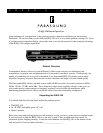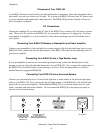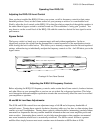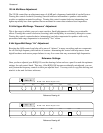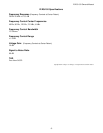
-3-
R/EQ-150 Owner's Manual
R/EQ-150 Room Equalizer
40 Hz
80 Hz
120 Hz
2.5 kHz
Bypass
Level
6 kHz
Operating Your R/EQ-150
Adjusting the R/EQ-150 Level Control
Once you have installed the R/EQ-150 into your system, set all its frequency controls to their center
detented positions. Next, set the volume control on your preamp or receiver to a comfortable level.
Finally, adjust the level control on the R/EQ-150 so that the relative output level through the speakers is
the same when its bypass switch is switched in and out. This establishes a “unity gain” position. You
may boost or cut the overall level of the R/EQ-150 with this control as desired for best signal to noise
performance.
Bypass Switch
The bypass switch is a handy way to compare music with and without equalization. In the on
(depressed) position, the signal from the preamplifier is routed around all of the equalization circuits
while leaving the level control active. This allows you to instantly compare between flat and equalized
settings without having to individually readjust the frequency controls to flat. An LED alerts you to the
bypass status.
Drawing # 2: Front Panel Controls
Adjusting the R/EQ-150 Frequency Controls
Before adjusting the R/EQ-150 frequency controls, make certain that all tone controls, loudness buttons,
and other filters on your preamplifier or receiver are set at their flat or bypassed positions. This helps
avoid interaction between multiple equalization circuits that can adversely affect the sound or overload
your amplifiers or speakers.
40 and 80 Hz Low Bass Adjustments:
The 40 Hz and 80 Hz controls have an adjustment range of ±8 dB and a frequency bandwidth of
one-half octave. Turning these controls clockwise (boosting) adds very low bass so often missing from
smaller or in-wall loudspeakers. Turning these controls counterclockwise (attenuating) can help reduce
unwanted low frequencies that may contain inaudible information that can waste amplifier power and
strain woofers. Attenuating these controls can also help tame boominess when speakers are mounted
near room boundaries where bass is acoustically reinforced. The 80 Hz control will have a greater
audible effect simply because most music contains more information at 80 Hz than at 40 Hz.



